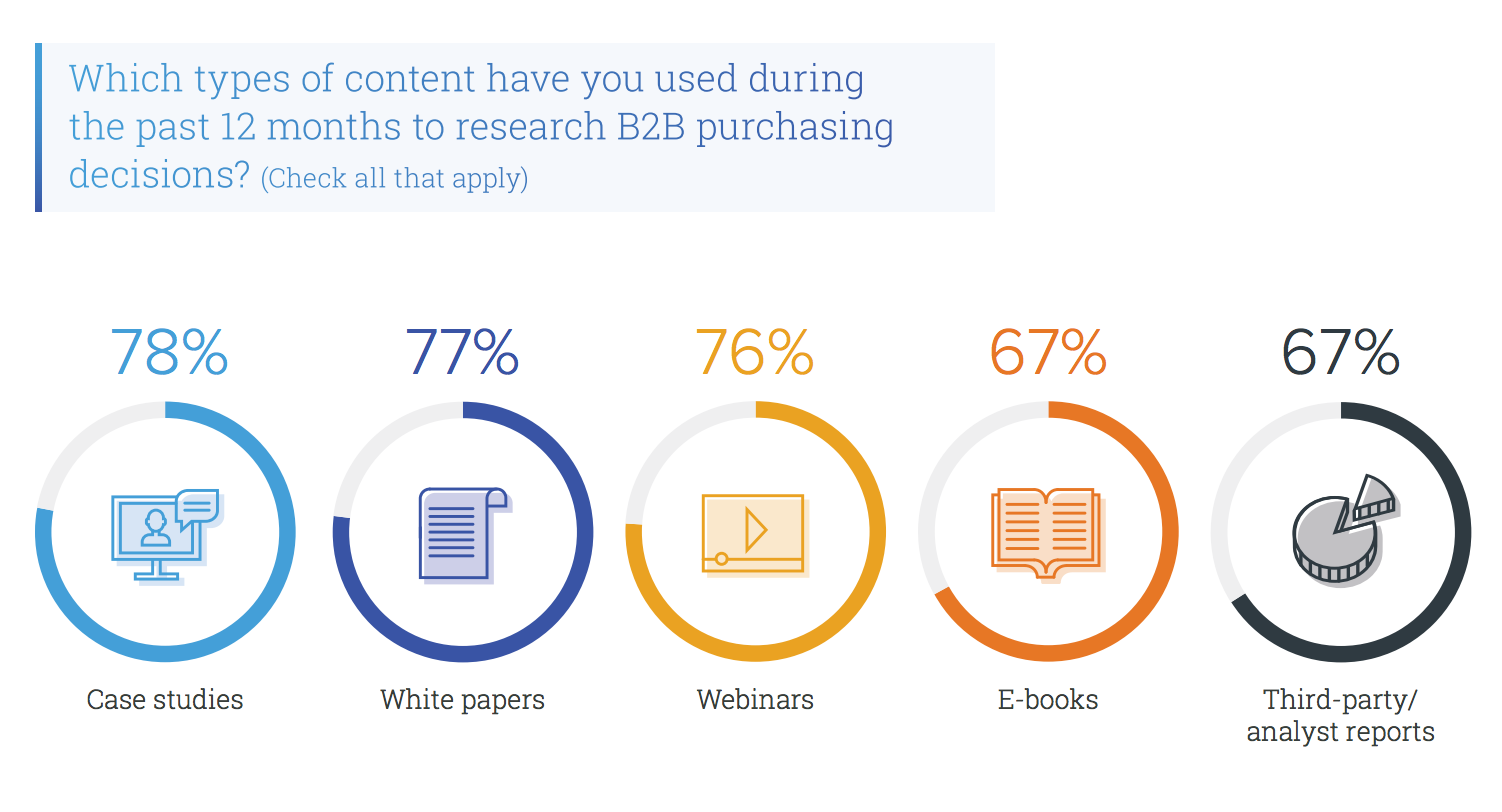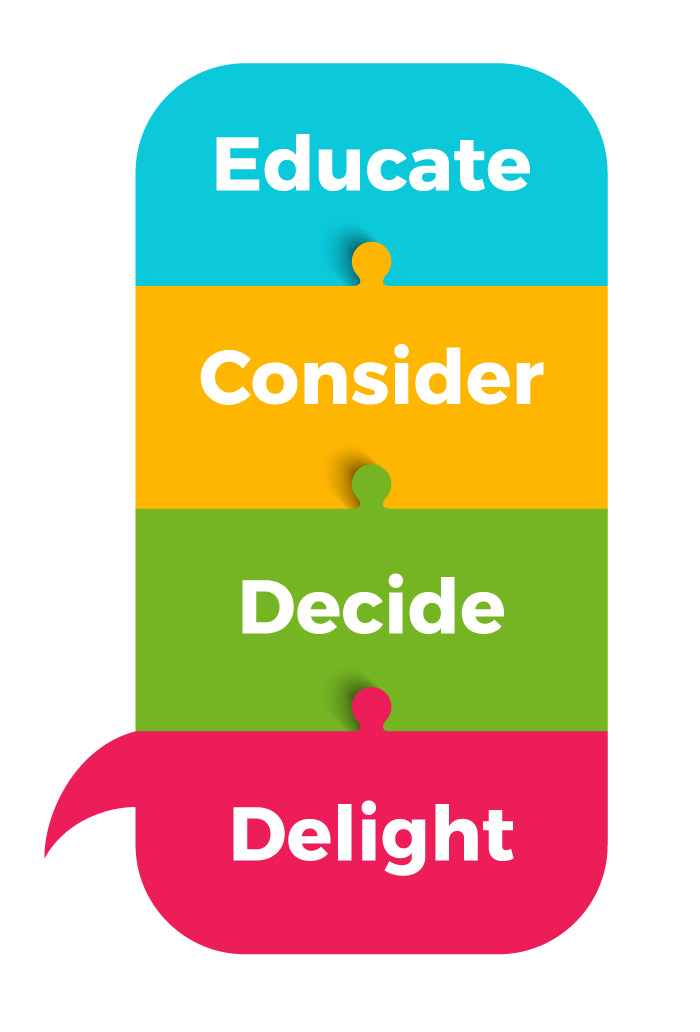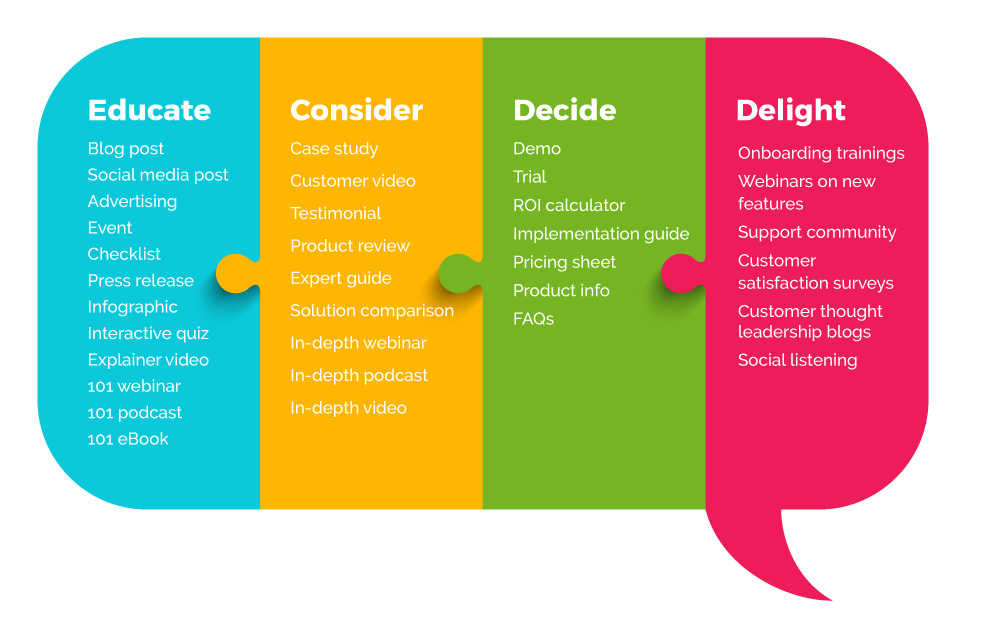So, what are we missing here? We’re creating a healthy amount of content, going with quality over quantity. We built buyer personas already and we’re keeping CEO Charles and Marketing Mary in mind for every blog post. We have a content strategy, a content vision, a content…
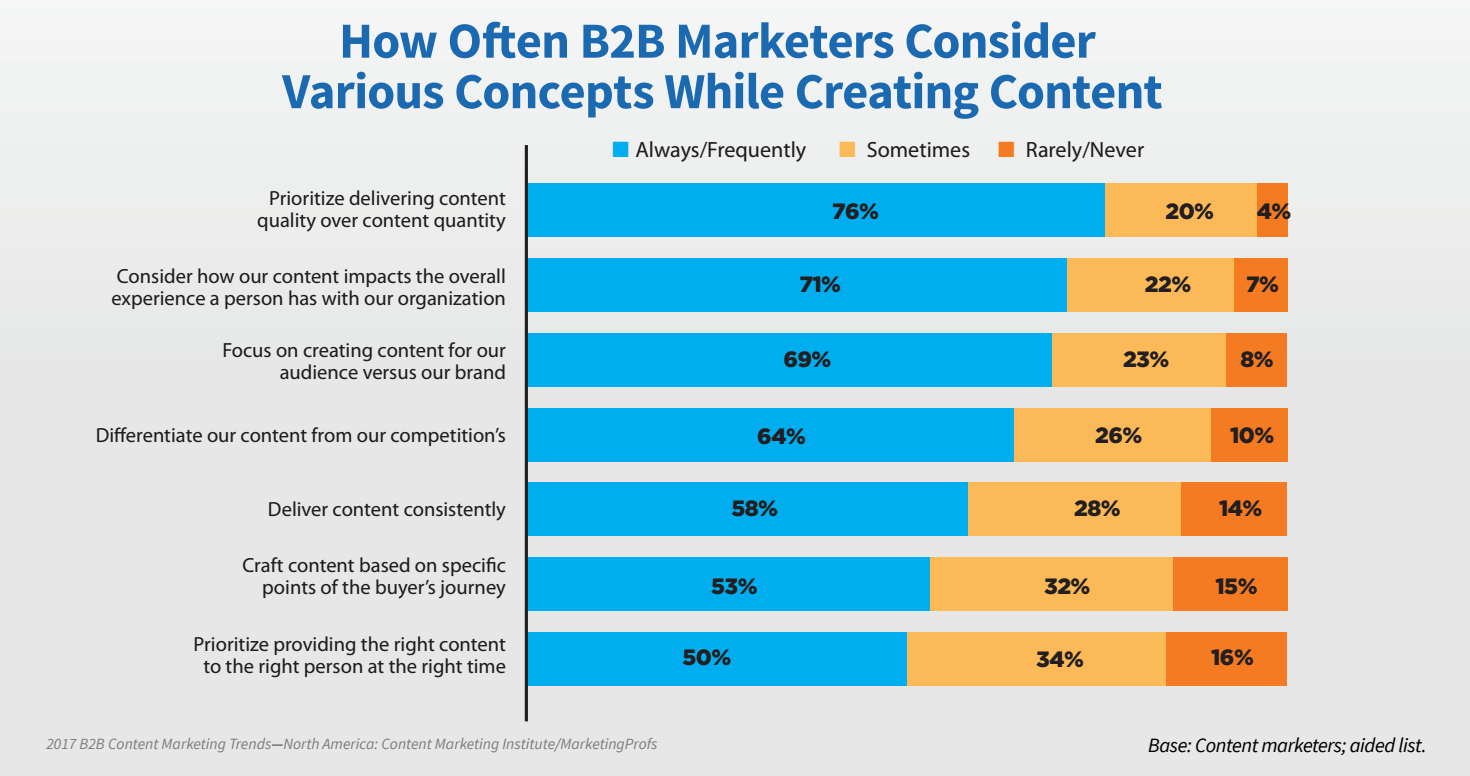
But — forgive us, this is a big “but” here so let’s try that again — BUT… we’re not covering content types in relation to buying stages.
Before you start creating content, remember the question you are looking to answer. When in doubt, think of your buyer looking at that content and asking the classic: What’s in it for me? If your content doesn’t answer that one question, it won’t be valuable enough to pique their interest. And, they will move on to someone who can give them the answer they’re searching for.
According to Content Marketing Institute, only 53% of B2B marketers are frequently crafting content based on the buyer’s journey. We know different types of content allow us to target different audiences. We’ve already mapped out content based on buyer personas, and now it’s time to zero in on the buyer’s journey.
Buyers are self-sufficient and methodical
It’s not a news flash that today’s buyers are self-educating before they even think about talking to a salesperson. You know… because you’re a buyer too. Whether a purchase is personal or professional, buyers are methodical with their research.
That research involved checking out the company’s website, reading a blog, retweeting an interesting article they shared on social media, returning to their website to read a case study, comparing and contrasting different services or products with reviews on a third party website…until finally deciding to schedule a demo and ask for pricing.
Some buyers will need to be educated on a problem they don’t even know they have yet, to make your solution or service the answer. Others know their problem all too well, and they need to be educated on why your solution or service is the answer over another. The remaining are done searching for a solution, so they make a choice — what they hope is the right answer — and they want validation.
How structure aligns our content with buyer expectations
The reality is this: The buying stages just aren’t a focus for a lot of content marketers, especially outside the B2B world. The brand is absolutely important, but so is the business.
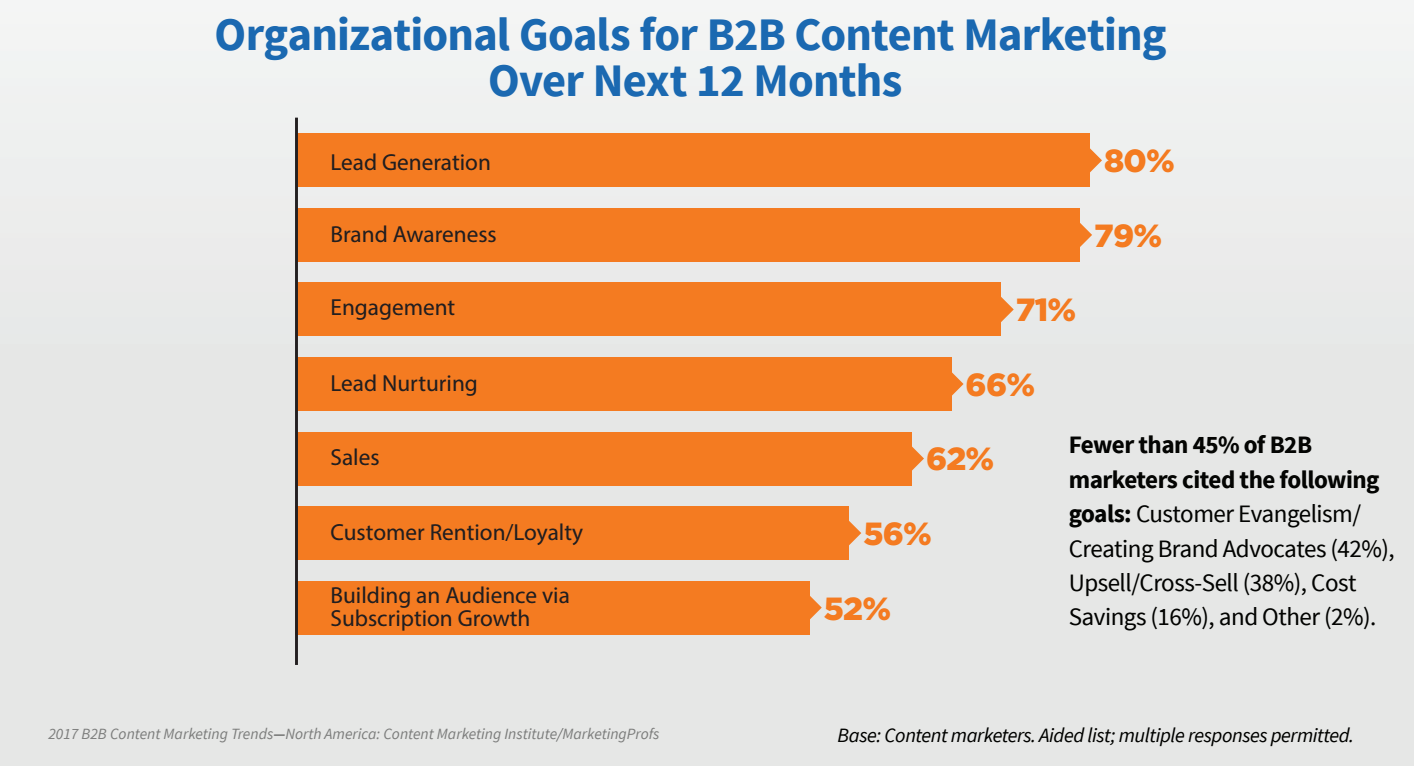
Creating content for the sake of content is what got us in trouble back in the day — and called a cost center to boot. A modern marketing department is a profit center, because it lends an important hand in revenue generation.
No longer is marketing running off to their corner to create cool content that “might” go over well, while sales is in the other corner doing random cold calls because they have no leads. The lines have become blurred, and the classic love-hate relationship between sales and marketing has morphed into a tolerable marriage.
We need to avoid the fluff with that whole “if you build it, they will come” mantra, because we all know this is definitely not how content marketing works. We need to figure out exactly what types of content we should be posting and how various types of content generate leads.
Let’s take that even further with a mindset switch to help you really get the most out of the content you create…
- Instead of asking:
What types of content should we be posting? - Ask this:
How can the types of content we post help the buyer solve their problems?
And…
- Instead of asking:
How do various types of content generate leads? - Ask this:
How can we meet buyers on their terms (instead of ours) with the content we generate?
This is where the good ‘ol buying stages come in to save the day, giving us structure to keep our fleeting creative content hearts grounded when we see the next shiny idea and want to take flight.
Source: Demand Gen Report
Content that solves the buyer’s problems on their terms
Aligning content with the buying cycle means we are helping the buyer solve their problems by meeting the buyer on their terms, instead of ours. The result? Intentional content that leads a prospect down a particular path (or funnel, if you prefer) until they decide to become your buyer.
The buyer wasn’t born yesterday, and they expect more from organizations today than they did five years ago. They don’t want Blockbuster (remember them?). They want Amazon Prime.
They’ve seen it all, and they will go where they feel their expectations will be both met and exceeded. Using this thoughtful approach to content types involves creating what speaks to the buyer, where they are today on that path.
There are about a thousand names for these models. No matter what you call the buying stages, all models stand for basic principles that are money when it comes to understanding what kind of content you should be creating to reach buyers in these different stages — and ultimately, generate leads.
We’re going with Educate, Consider, Decide, and a fourth — to represent the often forgotten stage after the sales closes — Delight.
Four stages of the buyer’s journey for content:
1. Educate: Your content brings new possibility to their problem
Frankly, problems suck, but they certainly make life more interesting in any industry. An organization that’s growing rapidly or dealing with complexities will inevitably encounter problems. Much of the anxiety centered around this stems from the unknown, and feeling alone.
The good news is that plenty of other people have the same problem! So educational content can be that solution and provide a sense of camaraderie. The key is to focus on the solution aspect of every piece of content, rather than dwelling too much on the problem. In other words, no need to be the Debbie Downer of content.
A prospect is more likely to connect with a positive message. While it’s important to hit on the pain points with your content, you don’t want to hit them over the head with the pain they already know intimately. Focus on the community aspect of the problem, using big-picture examples in your industry, like compelling data and research that backs up what your content is hoping to solve.
Subtle is the key word during this stage, and how-to articles will go over well with this audience. You’re not jumping into features and benefits about your solution, because it has no place here. The buyer still isn’t so sure they need to buy anything. They’re self-educating, skulking around the internet for free information that will help them see the light at the end of the tunnel.
Educational content is Content Marketing 101, really. Content creation will be pretty aggressive to cast a wide net to people in this stage. Value is what you’re aiming for to attract and engage a prospect. You’re helping them understand the problem they’ve been facing for a while, so they will see you as the resource to turn to when they’re ready to consider a solution.
Buyer asks: Will you help me understand what it is I need to do here?
Your content answers with: Yes, because there are many ways we can help you out.
Sales funnel location: Early
Content types:
- Blog post
- Social media post
- Advertising
- Event
- Checklist
- Press release
- Infographic
- Interactive quiz
- Explainer video
- 101 webinar
- 101 podcast
- 101 eBook
2. Consider: Your content helps them solve their problem
Now the buyer knows about the problem, so they are past the need to consume 101 content—though they may occasionally. What they are really interested in is the quest for a solution. They’re over this problem they have, and they’re ready to move on with their lives.
Consideration content should give people an idea of what your organization would be like to work with and spotlight your expertise. This stage can sometimes be overlooked by content marketers, as there is a lot of emphasis on bringing in leads and closing deals. This is right in the middle. Without these types of content, an interested buyer will walk.
Curiosity drives the buyer to play the field a bit, see what kind of solutions are available to help them get out of the pickle they’ve been in for some time. These buyers crave solid information and they will attend one of your webinars, so they can interact with you and see what you can offer them. They also will devour case studies to hear success stories from people they can relate to.
Your content needs to provide in-depth education to encourage them to consider you as an authority in the space, rather than another solution in a sea of many. If the content works, your company will make it to the final cut because of the value you demonstrated.
Buyer asks: Will you give me an idea what it would be like to work with you?
Your content answers with: Yes, because we know you’ll see the value in this partnership.
Sales funnel location: Middle
Content types:
- Case study
- Customer video
- Testimonial
- Product review
- Expert guide
- Solution comparison
- In-depth webinar
- In-depth podcast
- In-depth video
3. Decide: Your content confirms their decision is the answer
Once your buyer has come this far and narrowed it down to a few contenders, the last thing you want to do is spook them with ho-hum, irrelevant content that leaves them feeling stranded—or worse, running off to the runner-up when they thought you were the winner. They’re well past educational content, because they’ve made up their mind.
Oddly, this stage doesn’t get the attention it deserves. It falls into the hands of busy sales teams who never get around to creating it. Marketing hears sales needs this content to help them close deals, but they’re busy fiddling around with the hefty content creation necessary to address the earlier stages of the funnel.
Buyers remorse happens with solutions and services, just like it does with the abandoned shopping cart online when you got distracted or the outfit you returned because you hoped to find something a little better.
Decision stage content needs to reduce friction and aid the purchasing process so it’s smooth-sailing all the way to the signed contract. This validates their decision, so they can rest easy with the way you handled the situation. Now, they’ll know your solution was the answer to their problem all along and they’ll be happy with it.
Buyer asks: Will you make the buying part easy on me?
Your content answers with: Yes, because we want you to feel good about your decision.
Sales funnel location: Late
Content types:
- Demo
- Trial
- ROI calculator
- Implementation guide
- Pricing sheet
- Product info
- FAQs
4. Delight: Your content supports their overall success
When the sale closes, nothing closes for the customer. They are embarking on a new journey with your solution or service. This fourth stage is often forgotten, because it isn’t about a cut-and-dry transaction: It’s about the potential for a lasting partnership.
So, once the customer has decided to go with your offering, it’s your job to continue to support that decision and help them reach success. You’re not the only answer, but you are the one they have decided upon for now. To keep them as a customer, your content needs to nurture them as they continue to face everyday challenges.
How are you going to help them get the most out of your solution to meet these challenges? You need to be there for them, stay in touch, and provide continuous learning to help them achieve their goals. When you are truly delighting your customer through content, they will develop loyalty to your brand because you showed them the level of commitment they expected after they made their purchasing decision.
Out of the bunch, this buying stage is perhaps the most powerful and the most vulnerable. If we don’t focus on delighting the customer, we risk losing them to daily frustrations that send them straight into the arms of the competitor we thought we “beat” already.
If we do it right, and delight the customer, we have a grand opportunity to turn the customer into a loyalist to our cause, resulting in everything from upselling to referrals. Then we can change their name from customer to champion.
Buyer asks: Will you keep helping me with challenges as they come up?
Your content answers with: Yes, because we care about your ongoing success.
Sales funnel location: Off the grid
Content types:
- Onboarding trainings
- Webinars on new features
- Support community
- Customer satisfaction surveys
- Customer thought leadership blogs
- Social listening
Recap of content types for your buyers
We need to be both: the “brand first” marketer and the “business savvy” marketer. We need to know who we are and where we’re going as a company, but we also need to know who they are and where they’re going as a buyer.
It’s going beyond quality, and even beyond the buyer personas we so dutifully crafted for our content strategy. It’s going deep into the behaviors and actions a buyer takes, from the time they first see your logo to the moment they choose your solution and become your customer —and, hopefully one day, become a champion that stands by your brand.
